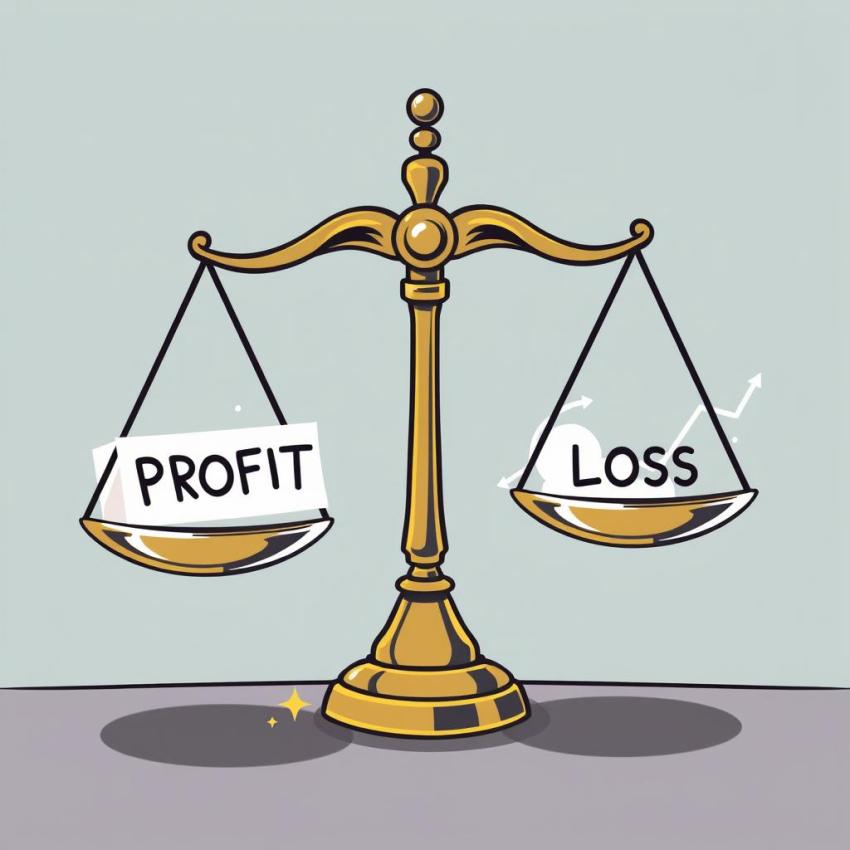Mastering Risk-Reward: Essential Insights for Every Trader
Get the crucial insights every trader needs about risk and reward. Make informed choices and grow your skills. Start mastering trading now!
Understanding Risk-Reward: What Every Trader Should Know
Understanding the concept of risk-reward is crucial for every trader aiming for success in the market. This idea serves as a valuable guide, enabling traders to evaluate their trades with greater insight.
By closely examining your win-loss rate, you gain the ability to identify the strengths and weaknesses of your trading strategies. This analysis is key to making necessary adjustments and improvements.
When you master the balance between risk and reward, you position yourself to make wiser trading decisions that can lead to more favorable outcomes over time.
What is Risk-Reward?
Risk-reward represents the balance between the potential loss, referred to as risk, and the potential gain, known as reward, associated with a specific trade. To evaluate a trade effectively, consider asking yourself two fundamental questions.
First, “How much could I lose if this trade does not go as planned?” This question identifies your risk. Next, contemplate, “What could I gain if this trade performs well?” This question helps you determine your reward.
For instance, imagine you are considering purchasing a stock priced at $50, with plans to sell it later at $70. In this scenario, your potential reward stands at $20. However, if the stock fails to meet your expectations and instead drops to $40, you would incur a loss of $10.
Therefore, you can calculate your risk-reward ratio, which in this case would be 1:2. This ratio indicates that for every dollar you risk, there is a possibility of earning two dollars in return. Understanding this relationship provides a foundational tool for traders to navigate the complexities of the market and to make informed decisions that align with their trading objectives.
Why is Understanding Risk-Reward Important?
You might wonder why risk-reward matters so much. The answer is simple: it can help you make more informed decisions. Knowing the risk helps you avoid impulsive trades that could lead to losses. Traders who ignore this concept often end up feeling lost or frustrated.
Imagine you're walking on a tightrope. If you don’t pay attention to your balance, you could fall. In trading, if you ignore the risk-reward balance, you might also fall—into heavy losses.
Also read:
Turning the Tables: How the Martingale System Can Change Trading Losses to Wins
Finding the Right Balance
Finding the right balance between risk and reward isn’t just about numbers—it’s also about mindset. Ask yourself, “Am I okay with the chance of losing this money?” If the answer is yes, then you might be ready to take that risk. If not, consider waiting for a better opportunity.
Traders often use a risk-reward ratio of at least 1:2. This means for every dollar you risk, you hope to gain at least two. This strategy gives you a safety net. Even if you lose a few trades, you can still come out ahead if your wins are larger.
Setting Stop-Loss and Take-Profit Points
To manage your risks, setting stop-loss and take-profit points is crucial. A stop-loss is like a safety net. It automatically sells your stock if it drops to a certain price. This way, you know exactly how much you could lose. Similarly, a take-profit point locks in your profit by selling when the stock hits your target price.
Think of stop-loss as a life jacket. It won't stop you from falling into the water, but it’ll keep you afloat when you do. Take-profit works like an anchor that keeps you from drifting too far away from your goals.
Mastering Your Money: Setting Stop-Loss and Take-Profit Points
Managing your investments can feel like walking a tightrope. One wrong step, and you might fall. But don’t worry! Setting stop-loss and take-profit points can act as your safety net, helping you stay balanced. Let's break down how these tools can protect your money while also maximizing your gains.
What is a Stop-Loss?
A stop-loss is a crucial tool in the world of investing, serving as a protective measure for your financial assets. Picture it as a safety net that steps in when your investments face a downturn.
When the price of a stock you own declines to a predetermined level, the stop-loss automatically triggers a sale of that stock. This feature is designed to prevent losses from escalating beyond a point you can tolerate.
Imagine watching a film that begins to lose your interest. At any moment, you can choose to leave the theater before the movie becomes unbearable. In a similar vein, a stop-loss provides you with the ability to exit a losing investment before it deteriorates further.
For instance, if you purchase shares of a company at $50, setting a stop-loss at $45 means your shares will be sold automatically if the price drops to that level.
This preemptive action protects your investment by ensuring you do not incur losses greater than you are prepared to handle. Ultimately, a stop-loss empowers you to take control of the financial risks associated with your investments.
Understanding Take-Profit Points
On the flip side, understanding take-profit points is equally essential. Just as a stop-loss helps limit potential losses, a take-profit point is a strategy for locking in your gains.
Think of it like placing a bookmark in a captivating book you are reading. You want to save that exciting moment before the story takes a turn for the worse. A take-profit point is established at a specific price where you intend to sell your stock and realize your profit.
For example, if you buy a stock at $50 and set your take-profit point at $60, the stock will automatically be sold once it reaches that price. This strategy allows you to capitalize on your earnings without allowing greed to cloud your judgment.By setting these points, you can effectively manage both potential losses and gains, creating a balanced approach to investing.
Why are Stop-Loss and Take-Profit Points Important?
Stop-loss and take-profit points are crucial elements of an effective investment strategy. They provide a structured approach to managing your finances while significantly lowering the emotional stress often associated with trading.
Emotional decision-making can lead to hasty actions based on fear or excitement, a common pitfall for many investors. By establishing stop-loss and take-profit points, you create a framework that helps maintain emotional equilibrium and keeps your trading on a steady course.
These points not only offer control but also promote adherence to your trading plan. Emotional trading often results in costly mistakes that can derail your financial goals.
By setting clear stop-loss and take-profit points, you commit to your strategy and avoid unpredictable behavior that can lead to losses. This disciplined approach contributes to long-term success and encourages a more rational perspective on market fluctuations.
How to Set Stop-Loss and Take-Profit Points
Analyze Your Investment: To effectively set stop-loss and take-profit points, start by analyzing your investment. Review the historical performance of the stock you are interested in.
Identify key support and resistance levels, which are price points at which the stock tends to reverse direction. This analysis gives you valuable insights and helps you determine optimal placement for your stop-loss and take-profit orders.
Choose Your Percentages: Many investors find it helpful to use specific percentage thresholds to inform their stop-loss and take-profit placements. A typical guideline is to set a stop-loss order around 5 to 10 percent below the entry price and a take-profit point approximately 10 to 20 percent above it. Feel free to adjust these levels based on your level of comfort and the volatility of the stock in question.
Monitor and Adjust: remember that the market is dynamic and ever-changing. Continuous monitoring of your investments is essential. Be prepared to adjust your stop-loss and take-profit points as needed.
For instance, if a stock experiences a steady rise and you feel more secure with a tighter stop-loss, it is entirely reasonable to make that adjustment. By staying engaged and adaptable in your approach, you can enhance your chances of achieving your investment goals while minimizing risk.
Conclusion: Mastering Risk-Reward
Mastering the balance of risk and reward is crucial for success in trading. This skill can significantly impact your performance and overall results.
At its core, it involves making informed choices, maintaining composure under pressure, and recognizing the right moments to take action. By gaining a clear understanding of risk-reward, you establish a strong foundation for your trading approach.
Each trade presents a fresh opportunity to profit, but it also comes with its own set of risks. Recognizing and analyzing these risks allows you to identify potential rewards more effectively.
Through consistent practice and experience, you will learn the importance of weighing these elements. This balance is essential for making more assured trading decisions.
As you navigate the trading world, remember to keep refining your understanding of these concepts. The clearer your grasp of risk and reward, the more confident you will become in executing your trades.
This clarity will empower you to make choices that align with your goals. Step into the market with a well-defined perspective on risk and reward, and you will enhance your chances of success.















13 Comments
hearsoon
2024-08-22T19:28
The market really has a lot of details and this is very difficult
mckein
2024-08-21T19:30
Yes, it is true that trading is a very difficult job
I once read somewhere that trading is the second hardest job in the world after mining
venoos
2024-03-07T19:27
It was a good tutorial, thank you
masterone
2023-08-06T19:22
Friends, does anyone understand options trading?
cr7
2023-08-08T19:24
This is a very detailed discussion, but simply put, options trading is trading a currency in the future, sort of like predicting whether a currency will go up or down in the future
gabana1
2025-01-07T19:32
Dont expect the market to be easy, you need to learn and gain skills and experience, then you can enjoy the market
nermin
2023-08-04T19:15
Excuse me, what is usually a good risk-to-reward ratio for trading?
joodione
2023-08-08T19:20
Depends on your trading strategy
Usually a risk to reward of 1:3 or higher is great
royal33
2023-08-04T22:03
I use a risk-to-reward ratio of 1:3 in trading
sara
2023-06-14T19:14
Your educational content is very useful. Please provide more education
Thank you
blackman
2023-03-15T19:12
This training is definitely important.
If a trade has a high risk-reward ratio, dont do it at all
samouel
2023-02-06T19:11
If I had followed this instruction, I would have lost less
gerrard
2023-01-01T19:09
Very educational and useful